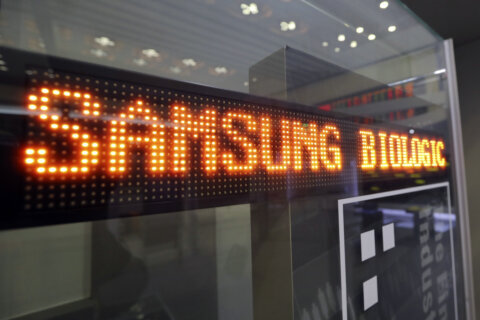This article was republished with permission from WTOP’s news partners at Maryland Matters. Sign up for Maryland Matters’ free email subscription today.
This content was republished with permission from WTOP’s news partners at Maryland Matters. Sign up for Maryland Matters’ free email subscription today.
In 2017, the Montgomery County Council declared a climate emergency and committed “to use all available powers and resources” to reach the ambitious goal of zero carbon emissions by 2035.
“When the council set the goals for addressing greenhouse gas emissions, we did not know how we were going to achieve them — we really didn’t know,” Montgomery County Executive Marc B. Elrich (D) said during a news conference earlier this week. Between 2015 and 2018, Montgomery’s greenhouse gas emissions declined by 3%.
Elrich was one of the council members who led the 2017 climate resolution effort. Now, four years later, as county executive, Elrich has unveiled a 300-page plan to get to zero carbon emissions by 2035, which he said is one of “the most ambitious climate goals in the country.”
If greenhouse gas emissions continue to increase, there could be 60 days a year with temperatures rising above 95 degrees Fahrenheit by the end of the century, according to the county’s climate projections. And some of the county’s stormwater systems can no longer manage the higher levels of rainfall and frequency of flooding, Elrich said.
“So much of our climate future — we don’t even have the authority to address because so many of the policy changes are made at the state level or the federal level,” said Council President Tom Hucker (D), the chair of the Transportation and Environment Committee and former state delegate.

“I can tell you from eight years of serving in Annapolis, the state government rarely does the right thing until Montgomery County does the right thing, so we all need to step up and stay involved to get Montgomery County laws on the books to help the state take action as well,” he continued.
Earlier this year, the Maryland Department of the Environment released a document outlining the state’s plan to reduce greenhouse gas emissions by 50% of 2006 levels by 2030 and to reach net-zero emissions by 2045. In addition, a state bill that called for a 60% reduction by 2030 moved through the General Assembly this year, but collapsed at the last minute when the House and Senate failed to compromise.
Montgomery’s climate action plan lays out 86 actions that would get the county to reach its goal, and officials plan to start working on 75 of the proposals this year. But it is a “living document,” which means that every year, the county will revisit the plan to evaluate new climate technology, determine specific funding sources for that fiscal year, plan legislative agendas at the county, state and federal level, and establish which climate actions to prioritize, officials said.
The county will spend at least $650,000 this year to implement the plan, according to Adriana Hochberg, the county’s climate change coordinator.
One of the most fundamental proposals included in the plan is to decarbonize the electricity supplied to the county. After two failed iterations, a state bill that allows Montgomery County to purchase renewable energy on the behalf of all residents passed the General Assembly this year.
Through a new program, residents would have to actively opt out if they wanted to buy traditional electricity coming from natural gas or coal. Currently, residents have to actively choose to buy power from renewable energy sources.
“Right now, the state’s trajectory towards 100% clean energy is a bit more slow than the county’s trajectory towards zero greenhouse gas emissions, so the county needs a way to get the electricity that is used by its 1 million residents and businesses to be 100% clean as quickly as possible,” said Del. Lorig Charkoudian (D-Montgomery), a lead sponsor of the bill.
Montgomery County’s community choice energy program will make it possible to get to a 100% clean energy grid and to negotiate a price that is lower than what residents are currently paying, Charkoudian said.
Since half of Montgomery’s greenhouse gas emissions came from buildings in 2018, electrifying buildings is another critical proposal included in Montgomery’s climate action plan.
According to this year’s work plan, the county plans to adopt the 2018 International Green Construction Code, which the council will review in September.
The county will also develop regulations for building energy performance standards, which requires large buildings to improve their energy efficiency, Hochberg said. There will be a public hearing on the bill next month, she said.
“If we cannot pass the [Building Energy Performance Standards] and do not adopt the green building code, there is no climate plan; there is no achieving goals by 2027 or 2035,” Elrich said. “There is no in between.”
The county’s plan also includes a proposal to ban natural gas in new buildings, but Montgomery leaders claim that state law needs to be modified to allow local jurisdictions to pursue a natural gas ban, which the county will work on as part of its state legislative agenda for next year, Hochberg said.
On transportation, which is the second largest source of greenhouse gas emissions for the county, the plan includes proposals to expand public transit and bike lanes, limit major new road construction and create tax incentives for electric vehicles.
In February, Montgomery County Public Schools signed a contract to add over 300 electric school buses to its fleet over the next few years, with the goal to gradually convert its entire fleet to electric buses by 2035.
Elrich emphasized that for this plan to work, personal action is needed as well. This means no more natural gas stoves, replacing gas-powered cars with electric vehicles, using public transit more often, and installing solar panels on rooftops.
“We can lay out the plan, we can dictate everything we can dictate, but if people don’t adopt it, if people aren’t willing to do it, we won’t get there. This has to be something that we’re all in together,” he said.
One difference between the draft plan released in December and the final climate action plan is a Community Justice Academy, which includes “community ambassadors” who will be responsible for educating their neighbors about climate change and encouraging carbon-reducing behavior.
Although having an ambitious goal to reduce all emissions by 2035 is a step forward, Del. Kumar P. Barve (D-Montgomery), the chairman of the House Environment and Transportation Committee, said it is misleading to call the county’s document a “plan.”
“A plan has specific goals, milestones and metrics against which to measure attainment,” Barve said.
For example, a proposal to mandate that half of the county-owned vehicles be electric or that a certain number of megawatts of solar energy be installed by a certain date, are actions that would entail a plan, he continued. Barve has been critical of county council legislation that he argues has limited the ability of property owners to install large solar arrays on agricultural land in Montgomery.
Still, “we’re moving the ball down the field and we’re going further with this plan than we’ve ever gone before in terms of providing clarity and a blueprint for the actions that the county needs to do to achieve our zero emissions goal by 2035,” Hochberg said.
“No plan can be perfect — knowledge is always evolving, technology is evolving — this is a fast-changing field,” she said.
With the final climate action plan completed, the next immediate steps will be to establish a framework for the Community Choice Energy Program, tighten up building energy performance standards and expand public transit, Hochberg said.
“We’re kind of like an octopus — we can’t afford to focus on one thing and then go to the next, there is work happening on all fronts,” she said.
The county has “to figure out how to walk and chew gum at the same time,” Elrich said. “Climate change is not going to be some sequential thing.”








